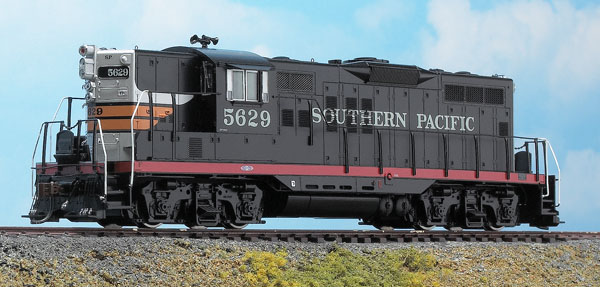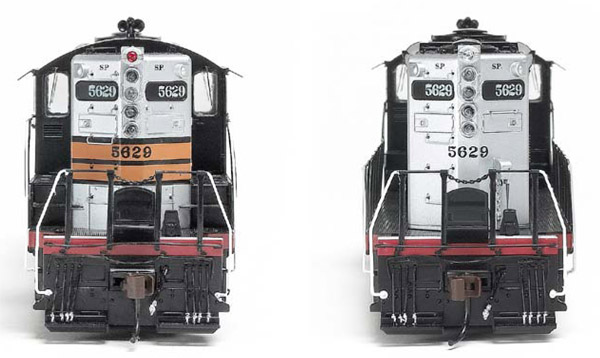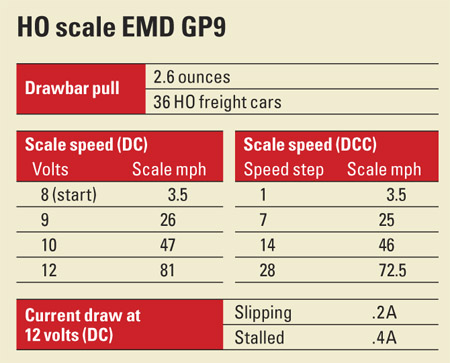The prototype. General Motors’ Electro-Motive Division introduced the 1,750-hp GP9 in 1954 as the successor to the 1,500 hp GP7. Externally the locomotives looked very similar and shared the same basic dimensions. Most of the differences involve the placement and number of louvers along the long hood.
Electro-Motive had built 4,092 GP9 and 165 GP9B locomotives when production ended in 1963. The Southern Pacific purchased 340 GP9 locomotives between 1954 and 1959. Many SP GP9s were rebuilt and modernized over their long careers. A few of these SP Geeps served into the 1990s.
The Athearn GP9 does have some dimensional discrepancies when compared to prototype photos and drawings in the Cyclopedia and in the April 1984 issue of Mainline Modeler. These discrepancies are within a couple scale inches.
Although that dimension doesn’t seem like a lot, the difference is noticeable because it affects the placement of larger details. For example, the height of the hood is two scale inches too short. This slight difference in height affects the placement of other details, such as the radiator grills, dynamic brake hatch, and cab. The cab window also measures two scale inches taller and wider than prototype drawings.
The SP “black widow” paint scheme has sharp separation between colors. Because of the height discrepancy noted above, the SOUTHERN PACIFIC lettering appears too low where it crosses the
engine-access door louvers when compared to prototype photos. However, all lettering is crisply defined and opaque.
Mechanism. After removing the front and rear coupler boxes I easily lifted off the locomotive’s plastic body shell. The motor and flywheels are mounted in the center of the die-cast metal frame. Two drive shafts connect the motor to gearboxes above the front and rear trucks. The frame has additional weights cast above each gearbox.
The printed-circuit (PC) board and DCC decoder are attached to the top of the motor. The speaker is mounted on top of the rear weight. Wires run from the PC board to the headlight assemblies in each end of the body shell.
I improved the slow speed performance on DCC by setting the decoder to 128 speed steps. After this adjustment the GP9 crawled along at less than 1 scale mph in speed step 1.
I also ran the GP9 on our club layout, the Milwaukee, Racine & Troy. This layout is controlled by a CVP EasyDCC system. The Geep’s headlights and sound remained steady during switching moves through no. 6 turnouts. The locomotive also hauled 15 coal gondolas up a 3 percent grade without stalling.
Sounds. The dual-mode SoundTraxx decoder features sound effects on DC and DCC layouts. The sounds are automatic on a DC layout, including increasing diesel rpm as the throttle is advanced and squealing brakes as the throttle is decreased. The decoder does a great job capturing the growl of a 16-cylinder 567C diesel engine. Other effects include the bell, which plays shortly after the locomotive begins moving, and a grade-crossing signal that sounds when the direction switch on the power pack is flipped. These can be turned off, but doing so requires a DCC system.
There are a lot more sound options when running the Athearn GP9 with DCC. User-triggered sound effects include a long and short horn blast, bell, and dynamic brakes. You can dim the headlight and turn on the dual oscillating signal lights. The topmost emergency warning light is non-functioning.
The model’s instruction booklet includes a listing of the decoder’s programmable configuration variables (CVs). More extensive user manuals are available at www.athearn.com/dcc.
The decoder includes a built-in seven-band equalizer. You can also adjust the volume level of individual sound effects, including the horn and bell.
Athearn is also selling a GP7 in Atchison, Topeka & Santa Fe and Pennsylvania road names. The model uses the same electronics and mechanism as the GP9. See www.athearn.com for a list of available road numbers.
The Athearn Genesis HO scale GP9 is definitely worth a look and a listen.
Manufacturer
Athearn Trains
1600 Forbes Way, Suite 120
Long Beach, CA 90810
athearn.com
Era: 1954 to 1965 as detailed
Road names (multiple road numbers): Southern Pacific, Boston & Maine (roller-bearing and solid-bearing truck versions), New York Central (freight and dual-service versions), Nickel Plate Road (Phase II and III versions), Seaboard Air Line, Union Pacific
Features
- All wheel drive and electrical pickup
- DCC socket accepts eight- or nine-pin decoder (DC version)
- Dual-mode SoundTraxx DCC sound decoder (DCC version only)
- Five-pole skew-wound motor with brass flywheels
- Metal wheels in gauge
- McHenry operating knuckle couplers at correct height
- Weight: 111⁄2 ounces

















